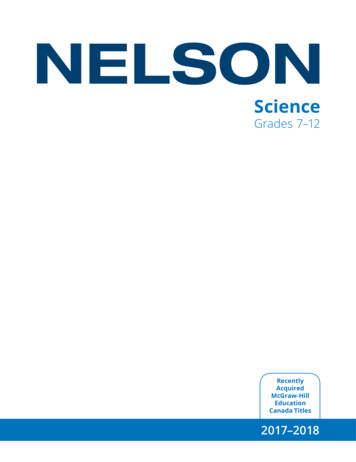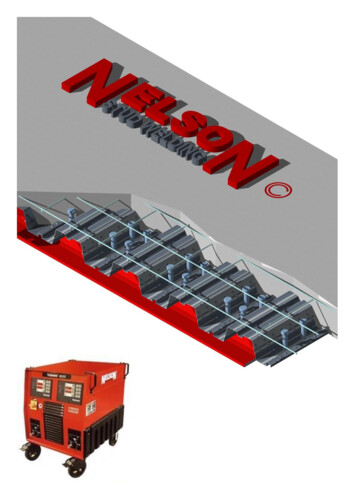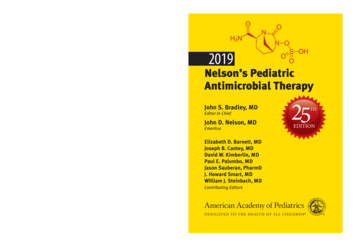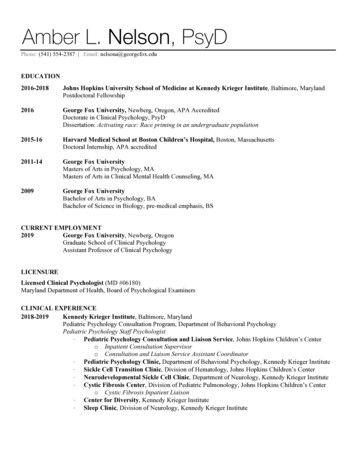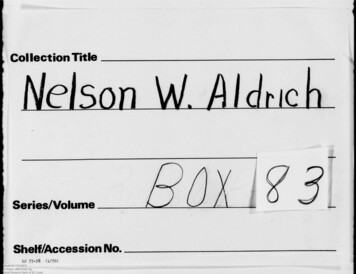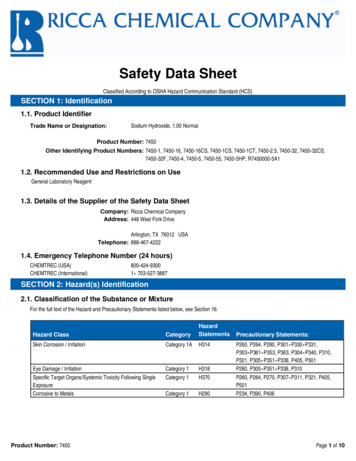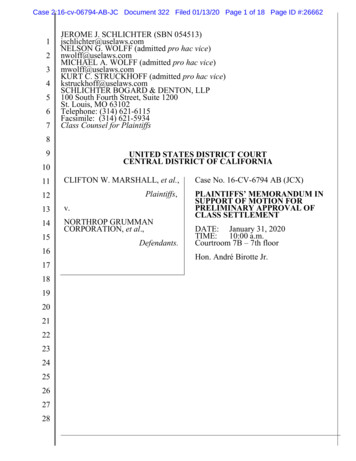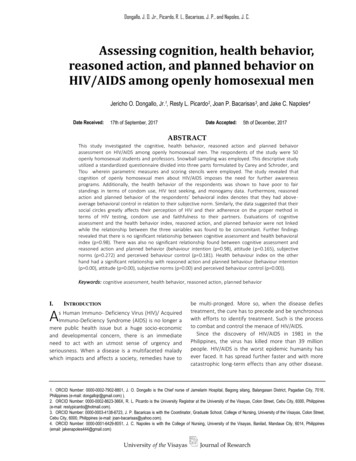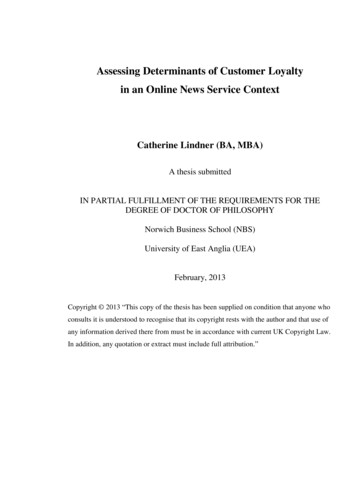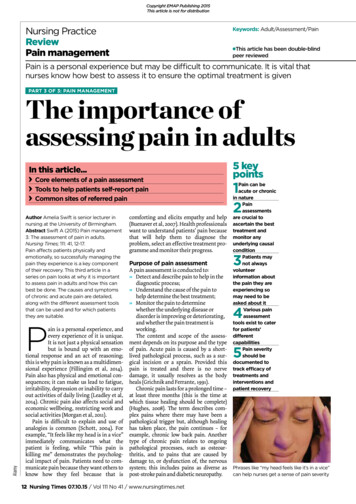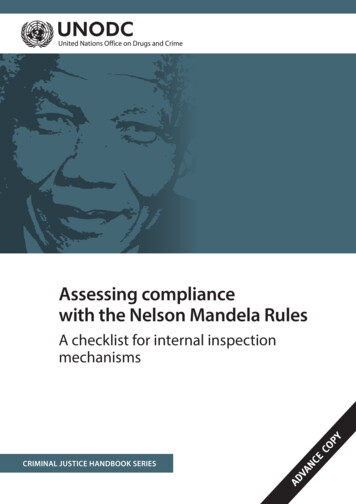
Transcription
Assessing compliancewith the Nelson Mandela RulesADVANCRIMINAL JUSTICE HANDBOOK SERIESCECOPYA checklist for internal inspectionmechanisms
UNITED NATIONS OFFICE ON DRUGS AND CRIMEViennaAssessing compliance withthe Nelson Mandela RulesA CHECKLIST FOR INTERNAL INSPECTION MECHANISMSUNITED NATIONSNew York, 2017
AcknowledgmentsThis checklist was written for the United Nations Office on Drugs and Crime (UNODC)by Walter Suntinger, consultant on human rights and criminal justice, and Philipp Meissner(UNODC). Contributing throughout the development of the checklist were Miriam Beringmeier and Piera Barzanò (UNODC).A first draft of the checklist was reviewed in the course of a meeting of the expert groupon the review of guidance material on the Nelson Mandela Rules held in Vienna on 9 and10 February 2017. UNODC wishes to acknowledge the valuable contributions received fromthe following national experts who participated in the meeting: Adel Jumaa Mubarak AlhallawiAlmaskari (United Arab Emirates), Yousef Rashed Alkhanbouli (United Arab Emirates), AliBen Aissa (Algeria), André Ferragne (France), Angelika Fichtinger (Austria), Maria JolantaGrochulska (Poland), Esteban Mahiques (Argentina), Vuyelwa Christa Mlomo-Ndlovu (SouthAfrica), Pee Eng Ong (Singapore), Juan Miguel Petit (Uruguay), Rick Raemisch (UnitedStates of America), João Vitor Rodrigues Loureiro (Brazil), Ruth Schröder (Germany) andVitaya Suriyawang (Thailand).UNODC also wishes to acknowledge the valuable input provided by the following ExpertGroup participants from other United Nations entities, international, regional and non- governmental organizations, and relevant research institutes as well as by the following individual experts: Vincent Ballon (International Committee of the Red Cross), Moritz Birk(Ludwig Boltzmann Institute), Jean-Sébastien Blanc (Association for the Prevention of Torture), Lipi Chowdhury (Department of Peacekeeping Operations of the United NationsSecretariat), Stefan Enggist (Federal Department of Home Affairs, Switzerland), Isak Enstrom(United Nations Development Programme), Emilio Ginés Santidrián (Subcommittee on Prevention of Torture and other Cruel, Inhuman or Degrading Treatment or Punishment),Andrea Huber (Penal Reform International), Agneta Johnson (Swedish Prison and ProbationService), Susanna Marietti (Antigone Onlus), Mary Murphy (International Committee of theRed Cross), Michael Neurauter (Council of Europe), Andra Nicolescu (American University),Josh Ounsted (Raoul Wallenberg Institute of Human Rights and Humanitarian Law), JoergPont (independent health expert), Mia Smith (Swedish Prison and Probation Service), William Thurbin (United Nations Office for Project Services), Emmanuel Wase (Departmentfor Peacekeeping Operations) and Hans Wolff (Division of Correctional Medicine and Psychiatry, Geneva University Hospitals).The following colleagues from UNODC equally contributed to the discussions during theExpert Group meetings: Muriel Jourdan-Ethvignot and Ehab Salah.UNODC also wishes to express its gratitude for the support provided by the Governmentof Germany towards the development of the checklist, including by funding the Expert Groupmeeting and the translation of the checklist into Arabic, French, Spanish and Russian.iii
“The way that a society treats its prisoners is one of the sharpest reflections of its character. ( ) The fullcontribution which our prisons can make towards a permanent reduction in the country’s crime rate liesalso in the way in which they treat prisoners. We cannot emphasize enough the importance of bothprofessionalism and respect for human rights.We need a climate that is conducive to prisoners becominglaw-abiding citizens.We will not find lasting solutions if we continue to treat our prisoners in the old way,denying them their dignity and their rights as humans.”Nelson Rolihlahla Mandelaon the occasion of the official launch of the project “Retrainingand human rights” of the Department of Correctional Servicesin Kroonstad, South Africa, on 25 June 1998.iv
Table of contentsI.Introduction 11.Context 22.Purpose 33.Target group 44.Characteristics 6II. Thematic areas addressed in the checklist 111.Basic principles of treatment 112.Safeguards 123.Material conditions of imprisonment 124.Security, order and discipline 135.Prison regime 146.Health care 157.Prison staff 16III. How to use the checklist 17The methodology for health-care inspections in prisons 18The methodology of inspecting human resources management in prisons 19IV. Checklist for assessing compliance with the Nelson Mandela Rules 211.Basic principles of treatment 212.Safeguards 274.Security, order and discipline 385.Prison regime 466.Health care 537.Prison staff 58Annex 67v
I.IntroductionThe Standard Minimum Rules for the Treatment of Prisoners have constituted the universallyacknowledged minimum standards for the management of prison facilities and the treatmentof prisoners, and have been of tremendous value and influence in the development of prisonlaws, policies and practices in Member States all over the world.1 Following an extensiveinter-governmental review process initiated to reflect advances in international law and correctional science, the General Assembly adopted, in 2015,2 a revised set of the rules as theUnited Nations Standard Minimum Rules for the Treatment of Prisoners (the Nelson Mandela Rules). A truly updated blueprint for prison management in the twenty-first century,the rules were to be known as the Nelson Mandela Rules in order to honour the legacy ofthe late President of South Africa, Nelson Rolihlahla Mandela, who had to spend 27 yearsin prison in the course of his struggle for human rights, democracy and the promotion of aculture of peace.Within the United Nations system, the United Nations Office on Drugs and Crime (UNODC)acts as the custodian of the international standards and norms related to the treatment ofprisoners, including the Nelson Mandela Rules. Accordingly, the General Assembly requestedUNODC to ensure the broad dissemination of the Nelson Mandela Rules, to design guidance material and to provide technical assistance and advisory services to Member States inthe field of penal reform in order to develop or strengthen penitentiary legislation, procedures,policies and practices in line with the rules.3 This checklist constitutes a direct response tothis request and forms part of the UNODC Global Programme on Addressing Prison Challenges, which provides for technical assistance geared at (a) reducing the scope of imprisonment; (b) improving prison conditions and strengthening prison management; and (c) supporting the social reintegration of prisoners upon release.1The Standard Minimum Rules for the Treatment of Prisoners were adopted by the First United NationsCongress on the Prevention of Crime and the Treatment of Offenders, in 1955, and approved by the Economicand Social Council in its resolutions 663 C (XXIV) of 31 July and 2076 (LXII) of 13 May 1977.2General Assembly resolution 70/175 entitled “United Nations Standard Minimum Rules for the Treatmentof Prisoners (the Nelson Mandela Rules)”.3General Assembly resolution 70/175, para. 15.1
2ASSESSING COMPLIANCE WITH THE NELSON MANDELA RULES1.ContextUnited Nations Standard Minimum Rules for the Treatment of Prisoners (the Nelson Mandela Rules)Rule 831. There shall be a twofold system of regular inspections of prisons and penal services:(a) Internal or administrative inspections conducted by the central prisonadministration;(b) External inspections conducted by a body independent of the prisonadministration, which may include competent international or regional bodies.2. In both cases, the objective of the inspections shall be to ensure that prisons aremanaged in accordance with existing laws, regulations, policies and procedures, with aview to bringing about the objectives of penal and corrections service, and that therights of prisoners are protected.Monitoring and inspection mechanisms shed a fresh and critical light on institutions which,by their very nature, are closed environments, and therefore require particular efforts tocounter the risk of abuse. The basic function of monitoring and inspecting prisons, whetherinternal or external, should be seen against this background. It is to contribute to a safe,secure and humane prison environment by (a) getting a proper understanding of all relevantaspects of prisons, including structural causes of any problems identified; (b) comparingactual prison conditions, management and practice against relevant provisions in nationaland international law, and by (c) submitting a report and recommendations on how theprison system and the treatment of prisoners could be improved. Through a constructivedialogue with national authorities they can be crucial to initiate change and reform with aview to helping prisons live up to minimum standards.The part of the Nelson Mandela Rules on internal and external inspections (rules 83-85),constitutes a major development vis-à-vis the vague formulation on the inspection of prisonsin the original version of the Standard Minimum Rules of 1955. These provisions are a clearreflection of the significant development of international standards and practice with regardto independent monitoring and inspections of prisons in recent decades, both at the international and national levels. Central to this development are the mechanisms for the prevention of torture through regular external visits to places of deprivation of liberty, in particularthe Subcommittee on Prevention of Torture and Other Cruel, Inhuman or Degrading Treatment or Punishment and the numerous national preventive mechanisms set up under theOptional Protocol to the Convention against Torture and Other Cruel, Inhuman or DegradingTreatment or Punishment.4, 5 As it was the provisions in the Optional Protocol, in particular,which inspired the language of rules 84 and 85 of the Nelson Mandela Rules, it is unsurprising, therefore that the guidance provided by the Nelson Mandela Rules on authority,United Nations, Treaty Series, vol. 2375, No. 24841.At the regional level, see also the European Committee for the Prevention of Torture and Inhuman or Degrading Treatment or Punishment, established under the European Convention for the Prevention of Torture and Inhuman or Degrading Treatment or Punishment of the Council of Europe; the Rapporteurship on the Rights of PersonsDeprived of their Liberty, established by the Inter-American Commission for Human Rights, 119th session (2004);and the Rapporteurship on Prisons, Conditions of Detention and Policing in Africa, established by the AfricanCommission on Human and Peoples’ Rights‚ twentieth ordinary session (1996).45
IntroductionChapter Icomposition and activities of inspection mechanisms has been developed primarily withexternal inspection mechanisms in mind.6The above notwithstanding, rule 83 of the Nelson Mandela Rules provides for a twofoldsystem for regular inspections of prisons, which is to consist not only of external inspectionsconducted by a body independent of the prison administrations, but also of internal oradministrative inspections to be conducted by the central prison administration.Internal inspections in the Prisons Service of KenyaThe Kenya Prisons Service (KPS) is currently implementing a programme of comprehensiveinternal inspections for compliance with the Nelson Mandela Rules. The programme, which hasbeen developed under the longstanding cooperation between KPS and the Raoul WallenbergInstitute for Human Rights and Humanitarian Law (RWI), sees small teams of officers visit aprison for a week-long inspection, using an instrument consisting of the Rules broken up intomore than 500 individual elements. Other international standards, such as the United NationsRules for the Treatment of Women Prisoners and Non-Custodial Measure for Women Offenders(the Bangkok Rules) are also included, where relevant, and at the end of the week, detailedreports on the findings are delivered to the officer in charge of the prison.The inspections are intended as a constructive process to help the prisons improve compliance,rather than criticize them for non-compliance. Following a first audit, the team will return to theconcerned prison for a second week, meeting with relevant section heads to assist them indeveloping action plans to address any rule not yet met in full. KPS has found that compliancewith most of the rules can be increased at little or no cost, with the focus on improving policies,procedures, training, documentation and accountability. Repeat inspections havedemonstrated that numerous prisons could make meaningful steps in meeting the rules,despite constraints faced in terms of resources.As well as monitoring change in compliance with the Rules, KPS uses the data from the auditsto inform the design of training programmes for prison staff, as well as reform priorities atnational level. Where common issues are identified across a range of institutions, KPS issuesnational policy directives to focus attention on priority areas that require attention andresource input. So far, nine prisons have been inspected — some of them multiple times — aspart of the KPS-RWI cooperation, while KPS has independently inspected another seveninstitutions. In the longer term, KPS plans to enshrine this programme as a standardizednational mechanism.Contribution submitted by the Kenya Prison Service/Raoul Wallenberg Institute in the course of the UNODCExpert Group meeting on the Review of Guidance Material on the Nelson Mandela Rules, held in Vienna, Austria,on 9 and 10 February 2017.2.PurposeIn the light of the above, the overall purpose of this checklist is to assist Member States inconducting internal or administrative inspections to assess compliance of their national prisonsystems with the Nelson Mandela Rules, and thus to facilitate the practical application ofthe Rules at nationa
III. How to use the checklist 17 The methodology for health-care inspections in prisons 18 The methodology of inspecting human resources management in prisons19 IV. Checklist for assessing compliance with the Nelson Mandela Rules 21 1. Basic principles of treatment 21 2. Safeguards 27 4. Security, order and discipline 38 5. Prison regime 46 6. Health care 53
